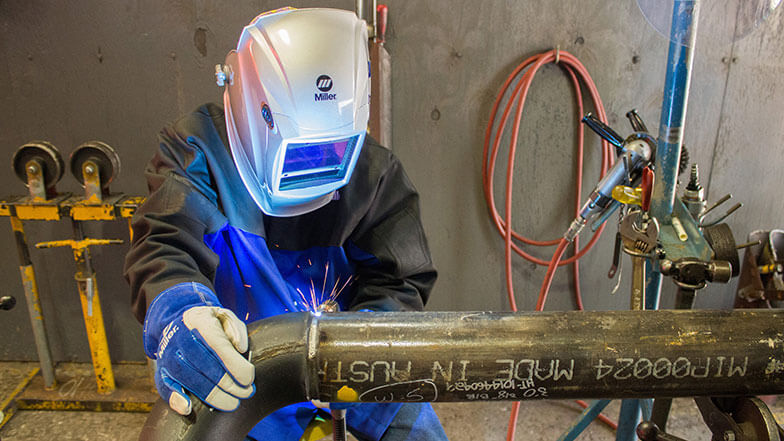
Wasted time and lost productivity are enemies in any welding operation. Many companies have seen significant productivity increases, without sacrificing quality, by converting from traditional welding processes such as stick or TIG to advanced wire processes, such as pulsed MIG and Regulated Metal Deposition (RMD®), a modified short-circuit MIG process from Miller Electric Mfg. LLC. These processes offer consistent weld quality and travel speeds that are three to four times those of stick or TIG.
A modified short-circuit MIG process such as RMD offers easy weld pool control thanks to more forgiveness to variations in stickout and gun angle. This helps reduce operator training time, along with delivering quality arc performance that helps boosts productivity. This process also produces less spatter and eliminates the need for backing gas, saving time and money.
Pulsed MIG offers better fusion and fill at the toes of the weld, higher travel speeds and deposition rates, and shorter changeover time, because the same wire and gas can be used with modified short-circuit MIG processes.
Improve Efficiency and Quality
Using newer welding approaches and directing the arc energy where it is needed allows novice and experienced welders to improve their skills. A more consistent arc is also easier to manipulate to ensure good fusion, resulting in better weld quality and less rework.
Advances in remote control welding technologies, such as also ArcReach® technology from Miller, gives welders complete control of parameters at the weld joint using the wire feeder or remote—eliminating the need to walk back to the power source to make changes. These technologies also reduce the likelihood of trips and falls.
Benefits of Advanced Technology
Many financial and business benefits can be realized by converting from traditional welding techniques and processes to more advanced solutions.
- Increased productivity. New machines can pay off quickly in increased productivity and other factors. For operations struggling to find and retain skilled welders, productivity improvements can help meet demands while making the most of the current workforce. If you source fabricated components from regions where labor costs are high, productivity improvements provide a significant cost reduction.
- Reduced scrap loss. With stick welding, a common goal for welders is to achieve stub loss (the portion of the electrode not deposited in the weld) of 2–3”, which translates to “planned scrap” of 16 to 25 percent of each electrode. Converting from stick to a wire process eliminates stub loss costs and produces labor savings because it is a more productive process.
- Fewer failures and rework. Consistent arc performance and filler metal selection are key to achieving higher first-time weld pass rates. Processes and technologies that offer more consistent arc performance can help reduce the time and money spent on weld failures and rework. A high level of rework impacts quality and can lead to delays, disrupting the entire flow of the construction process. (For more about the cost of rework and how to avoid it, see “Four Ways Specialty Contractors Can Reduce Construction Rework.”)
The Bottom Line
Understanding the potential productivity gains offered by advanced processes and new technologies can help ensure that jobs are completed on time and on budget. Change can be difficult, but companies willing to accept some level of risk might be rewarded with faster project completion, potential cost reductions, and better utilization of assets. Proper training is key to mitigating the risk.
For more information, visit www.millerwelds.com.


